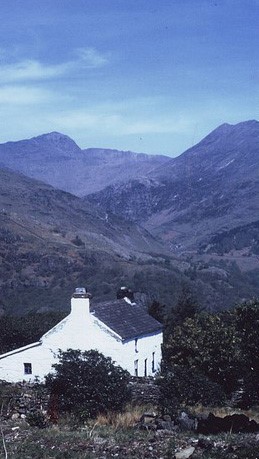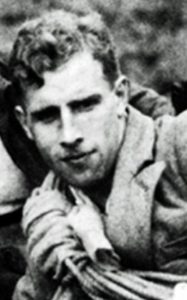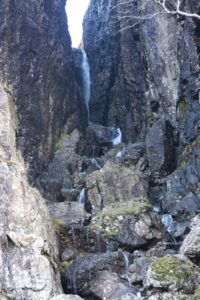Extract outlining Menlove Edwards’ admission to Denbigh taken from from Jim Perrin’s biography ‘Menlove’ published in 1993 (pp 242-243).
‘The weather was dismal, rain drifting in grey columns up the Llanberis Pass…
He stayed at Cwm Glas Cottage, set in a hollow between ice-scratched bluffs on the marshy hillside opposite Clogwyn y Grochan, and very recently bought by the Climbers’ Club as their third property in North Wales. Even today, with electric lighting, the cottage is gloomy, its bare walls and tiled floor making it cold and damp. If houses can be said to have atmospheres, this one’s is not of the happiest.
‘A group of Sandhurst cadets, arriving a few days after Menlove, found him in the bedroom at the rear of the cottage. He was in a coma, suffering from a drug overdose. The cadets ran to Ynys Ettws, half a mile away, and Roy Beard and Peter Hodgkinson came back with them. Menlove was taken by ambulance to the Caernarfon and Anglesey Hospital in Bangor where his stomach was pumped and he was given oxygen. He revived and struggled so powerfully that two men were hardly strong enough to restrain him. Stephen (his brother) was sent for and came immediately from Staindrop. The police had to be notified too (until 1961 attempted suicide was a criminal offence) and questioned him. The young doctor who was looking after his case asked if he would go voluntarily to Gwynfryn, the nearest mental hospital at Denbigh, or whether he would have to be committed in which case it would be harder for him to get out. He argued and refused and was certified and taken away, to spend the next four months at Gwynfryn.’
“I was brought in here while still semi-unconscious from a supposed attempt at suicide, and they unfortunately had me certified on that score, so I’ve been pretty much under their thumb, and no say at all in the matter of the treatment they wish to apply, which has been a rather vicious and long course of deep insulin.” 17.1.1950
‘Apart from the insulin, he was given electro-convulsive therapy. He was very sceptical, but resigned to everything the staff at the hospital were trying to do for him. Knowing that he was a doctor, they explained its supposed effects, and he accepted without argument. He was allowed to walk in the wintry lanes outside the hospital grounds, and given as much as he wanted to eat. Roy Beard visited him there, taking his young son along, and Menlove produced a seemingly endless supply of chocolate bars from his pocket. The goitre was by now very pronounced, he put on weight, the edges of his mouth puckered with an incessant bitter smile. He took his being in the hospital as further proof of the conspiracy by his friends or society to do him down.
‘On his discharge in February, the physician in whose care he had been wrote to tell Nowell (his sister) that he had suffered irreparable brain damage, and that sooner or later his suicide was inevitable. She had to live with that knowledge for another eight years.’[1]
After being discharged from Denbigh Menlove went to stay with a friend who was farming at Nantmor and they went climbing together but after six weeks he returned to Kent.
He continued to visit North Wales periodically for climbing holidays and, in 1952, had ‘great fun’ climbing in the Llanberis Pass where he set up a new route on Clogwyn y Ddisgl which would not be climbed again for almost 20 years. This holiday may have represented a high point of the years after Menlove’s Denbigh admission because, during subsequent trips to North Wales it became clear to companions that his mental condition was deteriorating. An old climbing partner who met him by chance on the summit of Tryfan found his conversation ‘irrational, confused, full of vague, dark references’.
In 1957 another old friend was persuaded to follow Menlove straight up the waterfall in the Devil’s Kitchen at Cwm Idwal (pictured above).
“We roped up at the bottom. Menlove led off and I belayed beneath a projecting rock, to get away from the spray, but the water still dripped down my neck. He squirmed into the vertical crack down which the stream flows, and fought his way up it, puffing and gasping for breath. I shouted up to him to say I didn’t want to do it, but the only reply I got was a bald head and a red face, glowering down from the black, dripping rock, looking like the very devil. Needless to say he completed the pitch and I too was forced to take the plunge.”[2]
This was his last new climb. In February the following year he committed suicide by swallowing a capsule of potassium cyanide.
Menlove’s ashes were brought to North Wales to be scattered from the knoll above Hafod Owen, the isolated cottage where he had lived for more than a year during the war. Jim Perrin describes the house:

‘From the knoll above the house you look straight up the winding valley of Cwm y Llan to Snowdon, at its head. The cottage is whitewashed and small, out of sight from most angles until you are almost upon it….Huge boulders give foundations to the whitewashed walls, the roof slates are as irregular as if wind-rippled, and the tumbledown dry-stone walling round about is mottled with pale green and grey lichens. There are few more lovely places in the whole of Wales.’[3]
Footnotes
[1] Jim Perrin (1993), Menlove, pp 242-243.
[2] Arvon Jones cited by Jim Perrin p 254.
[3] Jim Perrin (1993), Menlove, p. 201


